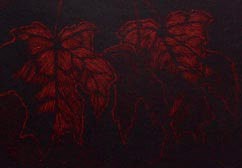In Teale's 1956 book Autumn Across America he refused to see leaf fall as a sad occasion, but bear in mind that he wrote this book as he was travelling across the country, not standing at his back door looking around the yard at all the jobs that didn't get done again over the summer.
He's right, of course—to heck with the jobs. Let's admire the brilliance and marvel for a moment at nature's chemistry, as he did.
A relatively small cast of chemical characters is responsible for the myriad leaf colors of autumn, colors which put on a new and different show every day, from the first hint of yellow in August to the browns of November.
Yellow pigments—carotene (plentiful in carrots) and xanthophyll (in egg yolks and canary feathers, among other things) — are present in leaves all summer but are masked by the intense green of chlorophyll. Photosynthesis breaks down chlorophyll, but production during the summer keeps pace with the loss. When cool fall weather slows chlorophyll production, the green begins to disappear, and the yellows shine through.
Yellow pigments and chlorophyll are found in the leaf cells' protoplasm, but anthocyanins, the pigments that cause reds, are in solution in the cell's sap. These are responsible for magentas and blues as well as reds and purples, and in addition to brightening fall foliage, they color flowers and fruits as unlike as red bananas, red cabbage, grapes and violets. The acidity of cell sap determines whether anthocyanins produce red or blue. If the cell sap is acid, bright reds will occur. If it is alkaline, there will be blues and purples.
Anthocyanins need sunlight to develop. To demonstrate this you can put a length of black electrical tape on the skin of an apple on a tree when it is about to turn from green to red. If you peel the tape off a few days later, you will see a green stripe on a red apple.
Because of this effect tree leaves are often reddest at the tips of branches where there is the most sun and they change delicately through orange to yellow at the inside of a tree.
Although it is cold that triggers the process of leaf color changes and leaf fall, the deciduous habit is thought to be an adaptation to drought, not cold. The leaves of deciduous trees, which lose huge amounts of water from their large surfaces, would be killed by dessication in winter, when soil water is locked up as ice and cannot be used to replace water lost to winter sun and wind.
Alas, all the leaf pigments are unstable, and even anthocyanins, which last the longest, oxidize in time and turn brown. By then the flags are flying no more, but the sweet, peppery smell of leaf decomposition is bracing and the increased amount of light that reaches the forest floor gives an unexpected radiance to grays and browns.


